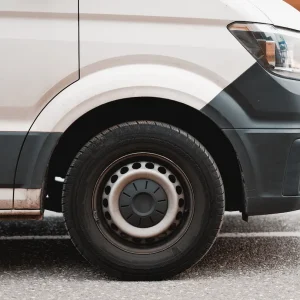Research issued by Michelin earlier this year suggesting there is no advantage to changing van tyres earlier than the 1.6 millimetre legal limit has divided opinion in the tyre industry.
According to the French tyre giant, a tyre worn down to the legal minimum “can perform as well as a brand-new tyre”. It also claimed that worn tyres could stop a van more quickly in the dry than the same tyre when new.
“If tyres are changed early, before the 1.6mm legal limit, this reduces the useful life of the product, and it means fleets are making unnecessary purchases. Early tyre removal also has a huge environmental impact,” Jamie McWhir, customer engineering support manager – Car, Van & 4×4 at Michelin Tyre told What Van?
When it released the report earlier this year, Michelin claimed early tyre switches could cost European drivers an extra £6.9bn a year in additional tyre purchases and extra fuel consumption through increased friction on the road surface.
Michelin also claimed that changing tyres too early would result in an extra 128 million tyres a year being used, causing an additional nine million tonnes of CO2 emissions through increased friction on the road and extra tyres being manufactured.
The firm likened changing tyres early to throwing away shoes because they needed to be cleaned, or putting a half-full tube of toothpaste in the bin. In addition, Michelin said it could not see a correlation between a decreased tread depth, down to a minimum of 1.6mm, and increased accident rates.

ABOVE: Jamie McWhir: Changing early reduces tyre life
McWhir conceded, however, that in certain situations it can be advisable to change tyres before they are worn out, adding these tyres are often kept as spares across the fleet: “Sometimes we see customers changing tyres early, but this is typically when they are being used in an intensive operation where there is no time for downtime – such as blue light work, or grocery home deliveries. In those exceptional circumstances, it’s not uncommon to see tyres being changed at 3-5mm, if it coincides with scheduled maintenance,” he said.
One of Michelin’s biggest rivals, Bridgestone, advocates changing rubber at 3mm, citing research from the Royal Society for the Prevention of Accidents, which recommends that they are changed when the tread depth is still almost double the legal minimum.
This view is shared by Apollo Vredestein, though the firm’s fleet and lease manager, Ricky Mitchell, believes other factors play their part: “Perhaps an even higher minimum of, say, 2mm may play a part in preventing potentially dangerous conditions, and that ought to be coupled with tyre husbandry: selecting the right tyre for the job, consistent maintenance protocols and bespoke tyre pressure settings for maximum yet safe tread wear,” he told What Van?
The Freight Transport Association, which has been campaigning for better van operator standards for a number of years, told What Van? it expects Van Excellence-approved firms to run legal tyres, with a minimum tread depth of 2mm.
“Tyres should certainly be checked regularly for uneven wear, faults and splits,” the body’s head of vans, Mark Cartwright said. Falken’s UK director, Matthew Smith, backs the 3mm switch, but said that “tyre safety is not merely about tread depth”, adding that other factors, such as the age of the tyre, pressures and how they are stored play a part.
While opinions differ on when the best time to change tyres is, the general consensus is that carrying heavy loads does not impact on the life and durability of the tyres, unless the vehicles are overloaded.

ABOVE: Weather conditions affect performance
“If the maximum load is exceeded or the inflation pressure used is inadequate for the load being carried, it will result in reduced service life, increased fuel consumption and, in severe cases, run the risk of tyre failure that could cause the loss of control of the vehicle,” Chris Baxter, technical service manager at Hankook Tyre told What Van?
And Andy Fern, fleet sales director at Kwik Fit GB, said: “Tyre mileage can be compromised through carrying high loads over sustained periods of time, especially if the van is typically performing urban jobs that involve sustained braking, acceleration and cornering.”
Fern – who until recently headed up Michelin’s fleet programme – also believes those who tend to overload their vans are likely to neglect other areas of van safety: “Van drivers should think about how they look after their own vehicle. If they are the type of person that checks tyres then no doubt they will check other areas of their vehicle,” he said.
McWhir agrees, saying Michelin has conducted thousands of fleet inspections across the country: “We find vans which are overloaded tend to be in a poorer condition. However, this doesn’t mean that those drivers who don’t overload their vehicles have perfectly maintained vans,” he said. “Overloading tends to come down to the application, and certain trades and business types will run close to or over weight limits more easily than others.”
However, the FTA’s Cartwright “has no concrete evidence” to support this theory. He instead advised van owners and operators to “ensure they are maintaining their vehicles to the highest possible standards” and use them legally and safely, while Bridgestone’s technical manager, Gary Powell, said that underinflated tyres will lead to overloading “even if the load carried is within the vehicle’s specification” and advised fleets to regularly check pressures “to ensure optimum tyre performance.”





